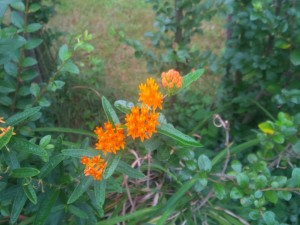
Monarch butterflies, known to their scientific friends as Danaus plexippus, abound this year—at least in the areas I frequent. Even though they are considered relatively common, I see them as miraculous. Backlit by bright midsummer sun, monarchs’ orange, black and white wings glow as they float from flower to flower. Unlike many other butterfly species, they are leisurely flyers and don’t indulge in a lot of superfluous fluttering. I am most appreciative of that trait when I am on vacation and stop rushing long enough to notice creatures that are hardwired to take their time.
Monarchs gravitate to milkweed, or Asclepias species, their one and only larval food source. If you want to tempt them to breed in your garden, you must grow it.
But common milkweed or Asclepias syriaca, which favors sunny spots in sparsely frequented places, has never found much favor in the average garden. This situation may be changing, but old-time horticulturists would point fingers at the plant’s “coarse” appearance and growth habit. The syriaca species stands three or more feet tall, with a stout stem and large, almost fleshy, ovate leaves. The globular flowerheads are made up of scores of tiny purple and white, honey-scented blossoms. During its early summer flowering season, common milkweed is a blatant pollinator seducer. Even when the flowers are not present, female monarchs seek the plants as egg-laying sites. Any time and anywhere that Asclepias disappears, the butterflies will follow suit.
You can buck conventional wisdom and grow common milkweed in your garden. The neighborhood monarchs will thank you. However, even if your sensibilities run to something a bit more genteel, you can still nurture both monarchs and milkweed.
In the last couple of decades, the horticultural fashion spotlight has shown brightly on butterfly weed or Asclepias tuberosa, a native “weed”, with flashy compound flowerheads in orange, or occasionally yellow. A tough, hardy plant, butterfly weed tolerates all manner of hostile conditions, including rocky, dry and poor soils, not to mention situations where deer may browse other plants. Though it is tall, like common milkweed, the leaves are narrow and the stems do not contain the milky white sap characteristic of many other Asclepias species. Happy butterfly weed plants will self seed, when the long, papery seed pods turn brown and split in the late summer or early fall. Nice size clumps will eventually form in your garden and monarchs will probably take notice. Other butterflies are also attracted to the nectar-rich blooms.
If your soil conditions are on the wet side, or you have one of the fashionable rain gardens, try swamp milkweed—Asclepias incarnata–another monarch and pollinator favorite. Bearing a greater resemblance to common milkweed than butterfly weed, the incarnata species produces pink-purple flower clusters at the tops of the stalks. A cultivated variety, ‘Ice Ballet’, offers white flowers instead. No matter what the flower color, the plants can grow tall—topping out at three to four feet—and work well at the middle of large beds or the back of smaller ones. The leaves are elongated and both foliage and stems contain the telltale white sap. Self-seeding is also characteristic of the incarnata species and, if monarchs could talk they would encourage you to let the seedlings sprout.
Depending on where you live, you may be able to grow other native milkweeds in your garden. The genus is moderately large, with at least 140 identified species. Local native plant societies, botanical institutions or Master Gardeners should be able to help you find sources of milkweeds native to your area.
As with almost any plant, milkweed comes with a caveat. The milky sap, which gives the genus its common name, may irritate human skin, so handle cut leaves and stems with care.
Milkweeds get their genus name from Asclepius, the Greek god of healing, who is famously invoked in the Hippocratic Oath taken by fledgling doctors. Milkweeds don’t go to medical school, but they heal the environment by sustaining those beautiful monarchs. Growing them is one of the best forms of ecological insurance.
If you want to get started with milkweeds, try the selection at White Flower Farm, P.O. Box 50, Route 63 ~ Litchfield, Connecticut 06759; (800) 503-9624; www.whiteflowerfarm.com. Free paper catalog.
